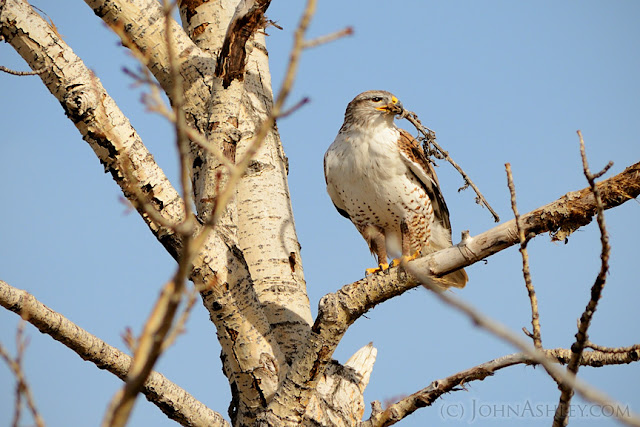 |
| Adult Ferruginous Hawk with new nesting material |
Last week I recorded my first "regal raptor" observation of the year, along the rolling grasslands north of Browning.
A Ferruginous (fer-OO-jin-us) Hawk flew in carrying a dried thistle stem in its beak - new nesting material. The hawk perched near a large stick nest but didn't actually add the stem, which makes me think it was the male of the monogamous pair, waiting for his mate - males deliver the material, females do the arranging. Both sexes have similar plumage, but Ferruginous females are much larger than males. A healthy female can soar on a wingspan of almost 5 feet, and tip the scales at almost 4 pounds.
Ferruginous Hawks (Buteo regalis) are the largest buteos in North America. They are big beautiful birds of dry, open country, favoring the rolling plains, native grasslands, shrub-steppe and deserts. They're midway in size between the other buteos and Golden Eagles, which they resemble in diet and nesting habits. Their common name comes from their rusty-brown (ferrous) back, wings and legs. The tail is pale rust above and white below. Their species name, regalis, comes from their royal stature among the admiring hawkwatchers. In Europe, Ferruginous Hawks are sometimes used in falconry, but the species has a reputation for independence.
 In Montana, Ferruginous Hawks are a state "Species of Concern," and all of our nesting pairs are migratory. They nest in the eastern three-quarters of our state, along the sparsely-treed and gently rolling plains that lie east of the forested Rockies. Nests are built at mid-elevation sites, such as the upper third of steep rock outcroppings. Ground nests in Montana are often oriented to the south. Historically, Ferruginous Hawks used bison bones in nest construction and lined their nests with bison hair.
In Montana, Ferruginous Hawks are a state "Species of Concern," and all of our nesting pairs are migratory. They nest in the eastern three-quarters of our state, along the sparsely-treed and gently rolling plains that lie east of the forested Rockies. Nests are built at mid-elevation sites, such as the upper third of steep rock outcroppings. Ground nests in Montana are often oriented to the south. Historically, Ferruginous Hawks used bison bones in nest construction and lined their nests with bison hair.Last year in northeastern Montana, the Nature Conservancy added a 16,000 acre conservation easement that will help protect nesting Ferruginous Hawks, among many other native animals. Also in 2012, Montana Audubon convinced a corporation to voluntarily relocate 25 wind turbines near the rocky cliffs of Kevin Rim, north of Shelby. The rim is a concentrated breeding area for 10 species of raptors, including Ferruginous Hawks.
Ferruginous Hawks don't nest in western Montana, but they're occasionally seen here during migration. In September of 2011, one handsome individual made the the local newspapers when he paused for a regal appearance at the grassy Lee Metcalf refuge in the Bitterroot Valley.
In the fall, our regal hawks migrate south during September and October, following grasslands to Oklahoma, Texas and Mexico for the winter. When spring returns, these hawks arrive back in southeastern Montana around mid-March, and back to the Centennial Valley during April and May. The Ferruginous Hawk I watched last week appears to have returned home almost a month earlier than normal.
 |
| Movements of one adult Ferruginous Hawk |
A five-year study using radio telemetry revealed an eastward movement, post-nesting but prior to winter migration, among many of the Ferruginous Hawks that nested in the grasslands of central Washington. As soon as nesting was complete, half of these adult hawks (n=10) flew over western Montana, over the Rocky Mountains, and spent the late-summer along the Rocky Mountain Front. Ferruginous Hawks from Oregon have also been documented flyng over to Montana. These birds were moving over and concentrating around populations of Richardson's ground squirrels. Come fall, all of the resident and non-resident Ferruginous Hawks migrated to wintering areas well south of Montana.
Some of these east-west, north-south movements are plotted on maps at the website, FerruginousHawks.org. But to see the real thing, you've got to get out and explore our native grasslands and prairies. Our migratory birds are back and ready to be admired.
 |
| Adult Ferruginous Hawk |

